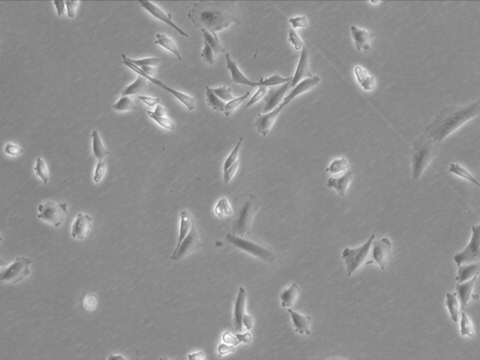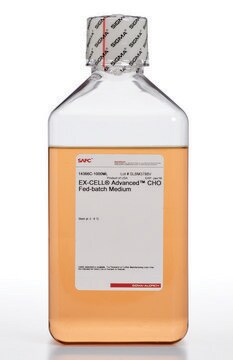Alle Fotos(3)
Wichtige Dokumente
CHOK1
CHOZN® CHO K1 Host Cell Line
Suspension-adapted in CD media
Anmeldenzur Ansicht organisationsspezifischer und vertraglich vereinbarter Preise
Alle Fotos(3)
About This Item
UNSPSC-Code:
12352200
Empfohlene Produkte
Beschreibung
CHOK1 cell line derived from ECACC CHO K1
Qualitätsniveau
Versandbedingung
dry ice
Lagertemp.
−196°C
Allgemeine Beschreibung
A subclone of the parental CHO cell line, which was derived from the ovary of an adult Chinese hamster. Cells require proline due to the absence of the gene for proline synthesis, the block in the biosynthetic chain lies in the step converting glutamic acid to glutamine γ serialdehyde. They undergo morphological changes in response to cholera toxin.
CHO-K1 cells derived from ECACC CHO K1 and adapted to suspension and serum-free, chemically defined media. Cells are cGMP banked in chemically defined, animal component-free EX-CELL® CD CHO Fusion medium.
Ursprung der Zelllinie
Hamster Chinese ovary. The parental CHO-K1 cell line was originated by Puck in 1957.
Physikalische Form
CHOZN CHO K1 cells are provided to customers in vials containing 1 mL at 107 cells/mL. Cells are banked in EX-CELL CD Fusion medium containing 4mM L glutamine and 7% DMSO.
Rechtliche Hinweise
The CHOZN CHO K1 cell line is sold for research use only. For use of this cell line in a commercial process, a commercial license must be taken.
CHOZN is a registered trademark of Merck KGaA, Darmstadt, Germany
EX-CELL is a registered trademark of Merck KGaA, Darmstadt, Germany
Lagerklassenschlüssel
10 - Combustible liquids
WGK
WGK 3
Flammpunkt (°F)
Not applicable
Flammpunkt (°C)
Not applicable
Hier finden Sie alle aktuellen Versionen:
Analysenzertifikate (COA)
Lot/Batch Number
Die passende Version wird nicht angezeigt?
Wenn Sie eine bestimmte Version benötigen, können Sie anhand der Lot- oder Chargennummer nach einem spezifischen Zertifikat suchen.
Besitzen Sie dieses Produkt bereits?
In der Dokumentenbibliothek finden Sie die Dokumentation zu den Produkten, die Sie kürzlich erworben haben.
T M Trask et al.
The Journal of biological chemistry, 275(32), 24400-24406 (2000-05-29)
Alignment of tropoelastin molecules during the process of elastogenesis is thought to require fibrillin-containing microfibrils. In this study, we have demonstrated that amino-terminal domains of two microfibrillar proteins, fibrillin-1 and fibrillin-2, interact with tropoelastin in solid phase binding assays. The
C Peters et al.
Scientific reports, 6, 31879-31879 (2016-09-02)
Dravet syndrome is the prototype of SCN1A-mutation associated epilepsies. It is characterised by prolonged seizures, typically provoked by fever. We describe the evaluation of an SCN1A mutation in a child with early-onset temperature-sensitive seizures. The patient carries a heterozygous missense
Clara Stead et al.
Journal of biomolecular screening, 21(10), 1042-1053 (2016-07-15)
Glycine receptor 3 (GlyRα3) is a ligand-gated ion channel of the cys-loop family that plays a key role in mediating inhibitory neurotransmission and regulation of pain signaling in the dorsal horn. Potentiation of GlyRα3 function is therefore of interest as
Junji Yamashita et al.
Journal of immunology (Baltimore, Md. : 1950), 191(2), 949-960 (2013-06-19)
Crohn's disease (CD) is a chronic inflammatory disorder of the gastrointestinal tract, where excessive Th1 cell responses are observed. We performed experiments to identify immunologically bioactive proteins in human plasma and found that paraoxonase (PON)-1, which has esterase activity and
Nouran Abualsaud et al.
Frontiers in cell and developmental biology, 8, 627090-627090 (2021-03-09)
Neuropeptide Y (NPY) has been implicated in the regulation of cellular motility under various physiological and pathological conditions, including cancer dissemination. Yet, the exact signaling pathways leading to these effects remain unknown. In a pediatric malignancy, neuroblastoma (NB), high NPY
Unser Team von Wissenschaftlern verfügt über Erfahrung in allen Forschungsbereichen einschließlich Life Science, Materialwissenschaften, chemischer Synthese, Chromatographie, Analytik und vielen mehr..
Setzen Sie sich mit dem technischen Dienst in Verbindung.




